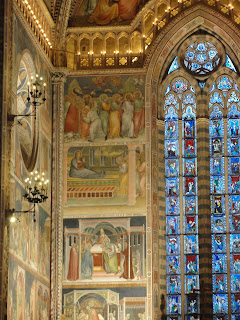Well, with both of our professors being gone (they had a death in the family to attend to), we were left without studio or seminar class. So instead, Serena took us on our trip to a few of the small towns near Orvieto. Now, I actually lied because 2 of the 3 towns are not actually in the Umbrian region, they're technically in Lazio, but we're all so close together that, so it counts.
We started in Bolsena. This is the Lake of Bolsena which is a volcanic crater lake. And there's an island out there, Isola Bisentina, that's owned by a Prince. Apparently it's really tropical and it has 7 churches on it representing the 7 churches that the Pilgrimage route stopped at in Rome.

The Basilica of Saint Christina. It lies along the Christian Pilgrimage road and is the place of two pretty spectacular stories: the life of Saint Christina and the Miracle of the Eucharist.

Inside the medieval church

This is the stone stained with blood from the Miracle of the Eucharist. Priest Peter from Prague went on a pilgrimage to revive his faith and along the way he stopped at this basilica and at mass, the Eucharist bled on him. The shroud that was bled on was taken to the Pope, then living in Orvieto for safety, so the Pope constructed the Orvieto Duomo in the name of this miracle and the Duomo houses the relic of the bled-on shroud. The festival of Corpus Christi is to honor this miracle.

Saint Cristina was only 14 when when she converted to Christianity. Her father, a ruling pagan, apparently tried to kill her 10 different times and each time she miraculously was kept alive. Her father tried to drown her in Lake Bolsena with this millstone tied around her neck, but she floated back to land unharmed atop the millstone (you can see two footprints on the stone where she stood)

Saint Christina was also burned, pulled apart with hooks, put on a torture wheel, and more until she finally died by an arrow to her heart. Here is her tomb in the catacombs under the church. They recently tested the few remains inside and they do indeed belong to a young girl who lived during the 3rd century AD.

The ancient Etruscan city gate along the Via Francigena, the Pilgrimage road from England to Rome

On to Civita di Bagnoregio! A tiny little hill town that's only accessibly by a land-bridge. Apparently only 5 people live here year round. Although it is the home to some of our K-State professor's summer villa that overlooks the valley... well la-dee-dah.

Around town. We found a trail that led to an Etruscan tunnel that goes UNDER the entire width of the city.

beautiful spring flowers in bloom (it was full of bees though)

A surviving medieval olive mill (Rick Steves Guide approved, said a sign outside). It's now a bruschetteria where we had an 8 euro "meal" of 2 slices of cheese and two slices of bruschetta with half a glass of wine.

Lot's of cats around, as usual in Italy. But this one was just too perfect!

And now for our vineyard tour and wine tasting in the countryside near the town of Sugano. It's family run by a couple and their son. Madonna del Latte is the name of the wine they produce and it comes from the name of the patron of Sugano.


The vineyard, disappointing to not be able to see them in full bloom and heavy with grapes. Guess I'll have to come back to Italy in the fall sometime. Interestingly, they plant a rose bush at the end of each row as an indicator because roses get attacked by diseases before the vines do.

A few leaves poking out on the vines.

The fermentation barrels.

oh and to top it off... they have an Etruscan tomb cave under their house... ya I got one of these in my house too... no biggie.

And this is when the scenario turns into a horror film as the nice wine people lead 30 curious students into a dead-end, 2000+ year old cave that used to be a tomb...
And to finish a wonderful day in the most beautiful part of Italy: drinking local wine and having snacks in the beautiful Umbrian countryside with friends... AHHHHHH Perfetto!







































































